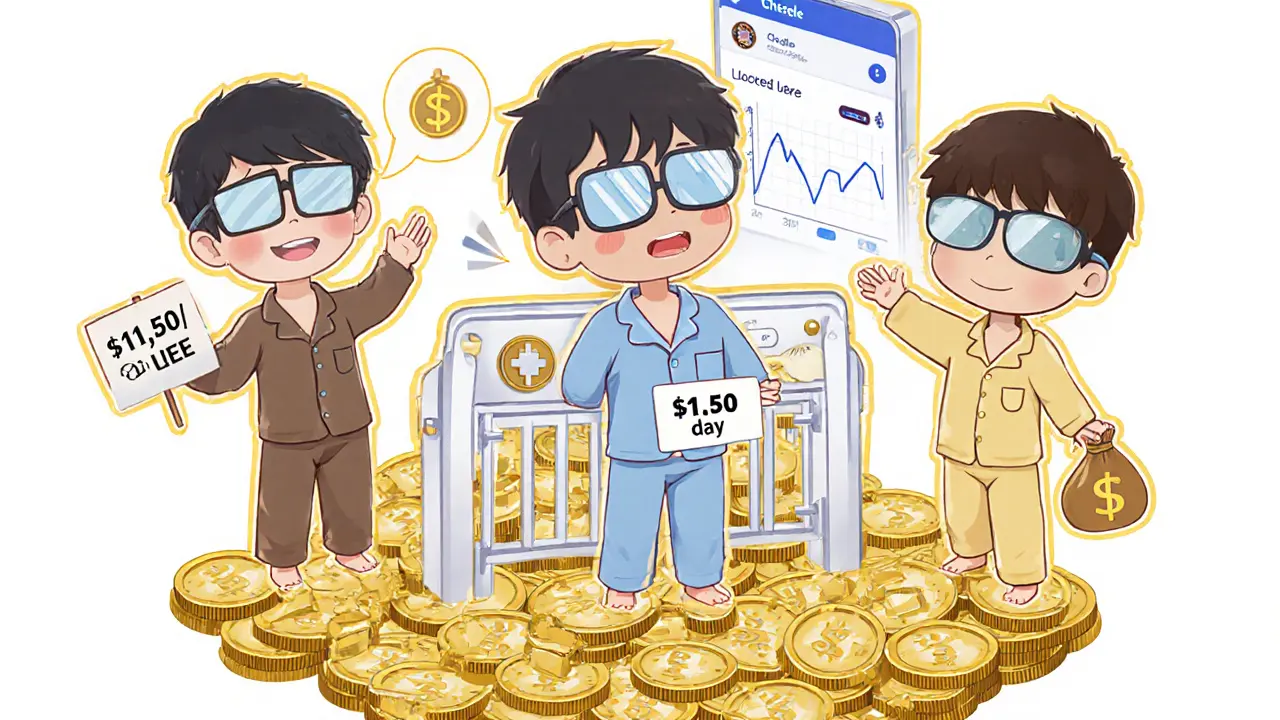LEE Earnings Calculator
Estimate Your LEE Earnings
Calculate potential daily earnings based on your viewing habits and upgrade status in Cheelee app
Estimated Earnings
Note: Earnings decrease by 7% monthly due to increasing mining difficulty
Love Earn Enjoy (LEE) isn’t just another crypto coin-it’s a token built around one simple idea: get paid for scrolling. If you’ve ever spent hours watching short videos on TikTok or Instagram, LEE says you should be earning for it. But is it real income or just another crypto hype cycle wrapped in a familiar app? Let’s cut through the noise.
How LEE Actually Works
Love Earn Enjoy (LEE) is the native token of Cheelee, a mobile app that blends TikTok-style short videos with a crypto reward system. You don’t need to create content. You don’t need to stake or trade. You just watch. Every video you watch in the app earns you LEE tokens. That’s it.
The system starts with free digital glasses-an NFT you get when you sign up. These glasses aren’t fancy. They cost $3 in value, but you don’t pay for them upfront. They’re given to you to start earning. With these, users report earning between $0.50 and $1.50 per day by watching videos. That’s roughly $3.50 to $10.50 a week. Sounds easy, right?
But here’s the catch: those earnings are capped. To make more, you need to upgrade your glasses. There are three tiers: Bronze, Silver, and Gold. Each upgrade costs more LEE tokens-and you need to buy them with the tokens you’ve earned. It’s a loop: watch to earn, earn to upgrade, upgrade to earn more. If you don’t invest more, your earnings stay small.
Tokenomics: Scarcity, Supply, and Mining Difficulty
LEE runs on the Binance Smart Chain, which keeps transaction fees low. That’s good news for users who want to move tokens without paying $20 in gas fees. The total supply is fixed at 7 billion LEE tokens. No more will ever be created.
What makes LEE unusual is how new tokens are released. Mining difficulty increases by 7% every month. That means the first LEE tokens were easy to earn. By month 12, it’s 84% harder to mine the same amount. The system is designed to slow down token creation over time, making each token potentially more valuable as the user base grows.
This isn’t inflationary like Bitcoin’s early days. It’s the opposite-deflationary pressure built into the algorithm. But here’s the problem: if no one joins the platform, the scarcity doesn’t matter. The value only rises if demand increases faster than supply. Right now, demand is thin.
Where You Can Trade LEE
As of late 2025, LEE is listed on only a handful of exchanges. The biggest is MEXC, where the LEE/USDT trading pair handles most of the volume-around $200,000 daily. You’ll also find it on Bybit and a few smaller platforms. But it’s not on Binance. Not on Coinbase. Not on Kraken.
That’s a red flag for most investors. Major exchanges act as gatekeepers. If a token isn’t listed there, it usually means one of two things: it’s too risky, or it’s too small. LEE is both. Its market cap sits around $5.4 billion at $0.77 per token, but that’s misleading. With only $200k in daily trading, liquidity is shallow. If 1,000 people try to sell at once, the price could drop fast.
Price predictions vary wildly. Some sites say LEE could hit $5 by 2026. Others say $0.90. The truth? Nobody knows. The token’s value is tied entirely to Cheelee’s growth. If 10 million people start using the app, the price might rise. If it stalls at 200,000 users, it could stagnate-or crash.

Who’s Using It? Real User Experiences
Reddit and MEXC forums are full of mixed reviews. Some users say they’ve withdrawn $10 after three weeks of daily watching. Others say they’ve spent weeks grinding only to hit a $5 withdrawal limit that won’t unlock until they earn $15.
One user on Reddit, u/CryptoCasual2023, wrote: “I watched 4 hours a day for 20 days. Got $12. Withdrawal fee was $3. Net profit: $9.” Another, CryptoSkeptic99, put it bluntly: “The math only works if you’re willing to invest in premium glasses. Otherwise, you’re just doing free labor for the app.”
Trustpilot shows an average rating of 3.2 out of 5 based on 127 reviews. Common complaints: slow customer support, unclear upgrade paths, and withdrawal delays. The app itself is easy to use-like TikTok with a crypto layer. But the backend feels like a prototype.
The Bigger Picture: Social Media Meets Crypto
Cheelee is trying to tap into the 4.6 billion people who use social media every day. That’s the dream: turn passive scrolling into passive income. But most people aren’t looking to earn crypto. They’re looking to be entertained.
Compare LEE to other Web3 social projects. STEPN rewards walking. Theta rewards sharing videos. Audius rewards music creators. LEE rewards viewers. That’s unique-but also risky. Content creators don’t get paid directly. The platform takes the ad revenue and redistributes it to watchers. That’s backwards from how social media has always worked.
Who’s incentivized to make good content? No one. That’s why most videos on Cheelee are low-effort, recycled clips. Without creators earning, the platform can’t grow sustainably. It’s a one-sided economy: users earn, but no one creates value.

Is LEE a Scam?
No, it’s not a scam. The token exists. The app works. People are earning real LEE. But it’s not a get-rich-quick scheme. It’s a low-yield, high-effort side hustle with a crypto twist.
The team behind Cheelee is anonymous. No whitepaper. No team photos. No public roadmap. That’s not illegal-but it’s not reassuring. Established projects like Decentraland or The Sandbox have public teams, audits, and community governance. LEE has none of that.
There’s also no independent security audit of the LEE smart contract. That means there could be hidden bugs, backdoors, or future changes that let the team freeze wallets or alter token supply. You’re trusting code written by unknown people.
Who Should Try LEE?
Only three types of people should bother with LEE:
- Curious social media users who want to test a new idea and don’t mind spending 30 minutes a day watching videos.
- Low-budget crypto experimenters who want to learn how GameFi apps work without risking big money.
- People who already use TikTok or Instagram and think, “Why not get paid for this?”
Don’t try LEE if you’re looking for:
- A long-term investment
- A reliable income stream
- High returns
- Security or transparency
If you’re in the first group, download the app. Get your free glasses. Watch for a week. See how much you earn. If you hit $5 and feel like it’s worth your time, keep going. If it feels like a chore, quit. It’s not worth your stress.
The Bottom Line
Love Earn Enjoy (LEE) is a real token with a real app and real users. But it’s not a revolution. It’s a test. A test of whether people will trade their attention for crypto instead of likes. So far, the answer is: only a few.
It’s not going to make you rich. But if you’re already scrolling anyway, why not earn a few cents? Just don’t expect more than that. And never invest more than you’re willing to lose.
Is LEE coin a good investment?
LEE isn’t a traditional investment. Its value depends entirely on the Cheelee app gaining millions of users. Right now, it has around 150,000 active users-far too few to drive serious price growth. If you’re looking for long-term gains, there are better options. If you’re curious and want to try a watch-to-earn model with minimal risk, it’s worth testing with time, not money.
Can I cash out LEE tokens for real money?
Yes, but it’s not simple. You need to transfer LEE from the Cheelee app to an exchange like MEXC, then trade it for USDT or another stablecoin. From there, you can withdraw to a bank account via a fiat gateway. Minimum withdrawal thresholds vary, but most users report needing $5-$10 before they can cash out. Withdrawal fees can eat into small earnings.
Do I have to pay to start earning with LEE?
No. You get free digital glasses when you sign up. These let you earn small amounts of LEE just by watching videos. You only need to spend LEE if you want to upgrade your glasses to earn more. That’s optional-but most users who earn significantly end up doing it.
Why isn’t LEE listed on Binance or Coinbase?
Major exchanges like Binance and Coinbase require strict criteria: high trading volume, strong community, legal compliance, and audits. LEE doesn’t meet these yet. Its daily volume is under $250,000, and the team is anonymous. Until Cheelee grows massively and adds transparency, listing on top exchanges is unlikely.
Is LEE safe to use?
The app itself is safe to download and use. But because there’s no public audit of the smart contract, there’s a risk of hidden vulnerabilities. Also, since the team is anonymous, there’s no accountability if something goes wrong. Treat it like a social experiment-not a bank.
How much time do I need to spend to earn with LEE?
Most users report earning $0.50-$1.50 per day by watching 30-60 minutes of videos. That’s about 5-10 minutes per video, with breaks in between. If you’re already scrolling TikTok, you can replace that with Cheelee and earn a little extra. But if you’re trying to make $100 a week, you’ll need to upgrade your glasses and spend hours daily-likely more than it’s worth.
What happens if Cheelee shuts down?
If Cheelee shuts down, LEE tokens lose their utility. You can still trade them on exchanges like MEXC, but without the app, there’s no new demand. The price would likely crash. This is the biggest risk: LEE has no value outside the Cheelee ecosystem. It’s not a standalone currency-it’s a platform token.



